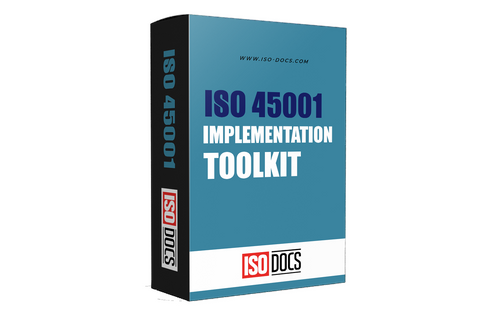ISO 45001 Policy Template
Introduction
The international standard that defines a framework of managing workplace occupational health and safety risks using formalized Occupational Health and Safety Management System (OHSMS) is ISO 45001. An ISO 45001 policy is a high-level declaration by the management of an organization detailing its dedication to mitigating risks in the workplace, wellbeing of its workers, and legal and other stipulations.

Why An ISO 45001 Policy Is Needed?
An ISO 45001 OHSMS policy is a must as it:
- Establishes effective organizational health and safety priorities and goals, which promote a productive, safe workplace.
-
Demonstrates leadership commitment toward the prevention of work-related injuries or illnesses.
- Gives a foundation of continual enhancement and regulatory adherence.
- In the absence of a well-developed OHS policy, there is a risk of legal punishment, loss of reputation, and low morale of the workforce.
Key Elements Of An ISO 45001 Policy
A good ISO 45001 policy must include the following, frequently summed up in a one-page quote and accompanied by comprehensive documentation:
-
Demonstration of OH&S commitment: Indicatively provide statement of commitment of the organization to safe and healthy working conditions, injury prevention and improvement.
-
Framework on OH&S Objectives: Restate the ways that the policy defines a framework of establishing occupational health and safety goals and performance indicators.
-
Legal and Other Requirements: Reaffirm the intent of the organization to abide by applicable legal, regulatory, and other requirements.
-
Hazard Elimination and Risk Reduction: State the purpose to remove hazards and minimize OH&S risk where feasible.
-
Worker Consultation and Participation: It is important to stress that health and safety decisions should be taken by employees and their representatives.
-
Communication, Training and Awareness: Become committed to the provision of required instructions, information and training to the employees.
- Ensuring Safe Conditions and Emergency Preparedness: Commit to ensuring safe facilities, equipment and processes- including emergency planning.

Action On ISO 45001 Policy- Action Points
In order to transform policy into practice organizations should go through the following steps which are structured:
-
Leadership Commitment: Get the top management on board and have safety initiatives publicly endorsed.
-
Gap Analysis: Compare the current health and safety management practices with the ISO 45001 requirements to understand what can be improved.
-
Drafting and Communication of the Policy: Prepare and distribute the policy document; make it accessible to all the employees and to the interested parties.
-
Setting Objectives and Plans: Translating policy into specific measurable OH&S objectives, in accordance with organizational goals; planning to accomplish those objectives.
-
Employee Involvement and Training: Involve workers in hazard identification, risk assessment, and controls development; conduct on-going education and training.
-
Identification of Hazard and Risk: Carry out frequent risk assessment and establish controls to eliminate or minimize hazards.
-
Legal and Regulatory Compliance: Keep up with evolving laws and be able to be in constant compliance by conducting routine review and audits.
-
Document and Review Procedures: Keep thorough OH&S documentation- policies, procedures, records, incident reports- and revise them periodically to keep them up to date.
-
Emergency Preparedness and Incident Investigation: Have established, drilled-out procedures to fire, evacuation and other emergencies; investigate incidents to root cause and implement corrective measures.
- Monitoring, Measurement, and Audit: Set KPIs of OHS performance, track the progress, and audit the OHSMS with the constant improvement.
Best Practices In The ISO 45001 Policy
The aim of this policy is to set the best practices for achieving ISO 45001.
-
Integrate with Other Management Systems: Co-location of the OHSMS policy with quality and environmental management (ISO 9001, ISO 14001) policies should be done to ease compliance and synergies.
-
Streamline Documentation and Communication: Main policy should be simple and concise, and the communication tools should be easy to use and readily understandable.
-
Develop a Safety Culture: Encouraging hazard and incident reports, safe behavior and success in occupational safety should be rewarded.
- Attentiveness: Regular meetings, safety committees and feedback should be used to facilitate regular contact with the employees.
Conclusion
The foundation of an efficient Occupational Health and Safety Management System is a strong ISO 45001 policy. It is not only a good declaration of organizational commitment and intent, but it gives the roadmap upon which a safe, legally compliant, and a constantly improving work place can be built. Through best practices, full involvement of all levels of employees, and with effective documentation, organizations can turn OHSMS policies on the boardroom commitments into day-to-day culture, which create actual changes in safety performance and business resilience.


